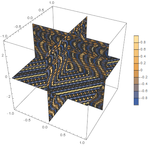SOCR News APS Ohio Spacekime 2021
Contents
[hide]SOCR News & Events: Data Science, Time Complexity, and Spacekime Analytics
Presenter
- Dr. Dinov is a professor of Health Behavior and Biological Sciences and Computational Medicine and Bioinformatics at the University of Michigan. He is a member of the Michigan Center for Applied and Interdisciplinary Mathematics (MCAIM) and a core member of the University of Michigan Comprehensive Cancer Center. Dr. Dinov serves as Director of the Statistics Online Computational Resource, Co-Director of the Center for Complexity and Self-management of Chronic Disease (CSCD Center), Co-Director of the multi-institutional Probability Distributome Project, Associate Director of the Michigan Institute for Data Science (MIDAS), and Associate Director of the Michigan Neuroscience Graduate Program (NGP). He is a member of the American Statistical Association (ASA), International Association for Statistical Education (IASE), American Mathematical Society (AMS), American Association for the Advancement of Science (AAAS), American Physical Society, and an Elected Member of the Institutional Statistical Institute (ISI).
Session Logistics
- Date/Time: Saturday, April 10, 2021, 8:00 AM–9:12 AM, Central Daylight Savings Time, CT (UTC-5)
- Title: Data Science, Time Complexity, and Spacekime Analytics
- Registration: Registration Link.
- URL: Official APS Ohio-Region Section Meeting Website.
- Conference: Spring 2021 Meeting of the APS Ohio-Region Section.
- Zoom: Zoom Link
- Session Format: Online virtual meeting (due to SARS-CoV-2 Pandemic).
- Session URL.
Abstract
There is a substantial need to develop, validate, productize, and support novel mathematical techniques, advanced statistical computing algorithms, transdisciplinary tools, and effective artificial intelligence applications. Extracting actionable information from complex, multi-source, and time-varying observable processes uncovers an interesting synergy between quantum mechanics, artificial intelligence (AI) and data science. Spacekime analytics is a new technique for modeling high-dimensional longitudinal data. This approach relies on extending the physical notions of time, events, particles, and wavefunctions to their AI counterparts; complex-time (kime), complex-events (kevents), data, and inference-functions.
We will illustrate how the kime-magnitude (longitudinal time order) and kime-direction (phase) affect the subsequent predictive analytics and the induced scientific inference. The mathematical foundation of spacekime calculus reveal various statistical implications including inferential uncertainty and a Bayesian formulation of spacekime analytics. Complexifying time allows the lifting of all commonly observed processes from the classical 4D Minkowski spacetime to a 5D spacekime manifold, where a number of interesting mathematical problems arise. Direct data science applications of spacekime analytics will be demonstrated using simulated data and clinical observations (e.g., structural and fMRI).
Background
- SOCR News & Events
- SOCR Global Users
- SOCR Navigators
- SOCR Datasets and Challenging Case-studies
- Electronic Textbooks:
Translate this page:
